We asked Corsair for a 2x48GB DDR5 6000MHz CL30 VENGEANCE kit to give our 9950X3D/RTX5090 PC additional memory over our current 2x32GB G.SKILL DDR5 6000 CL30 kit for comparison and to use for workstation and AI tasks. We were very surprised to receive two 2x48GB kits for a total of 192GB RAM!
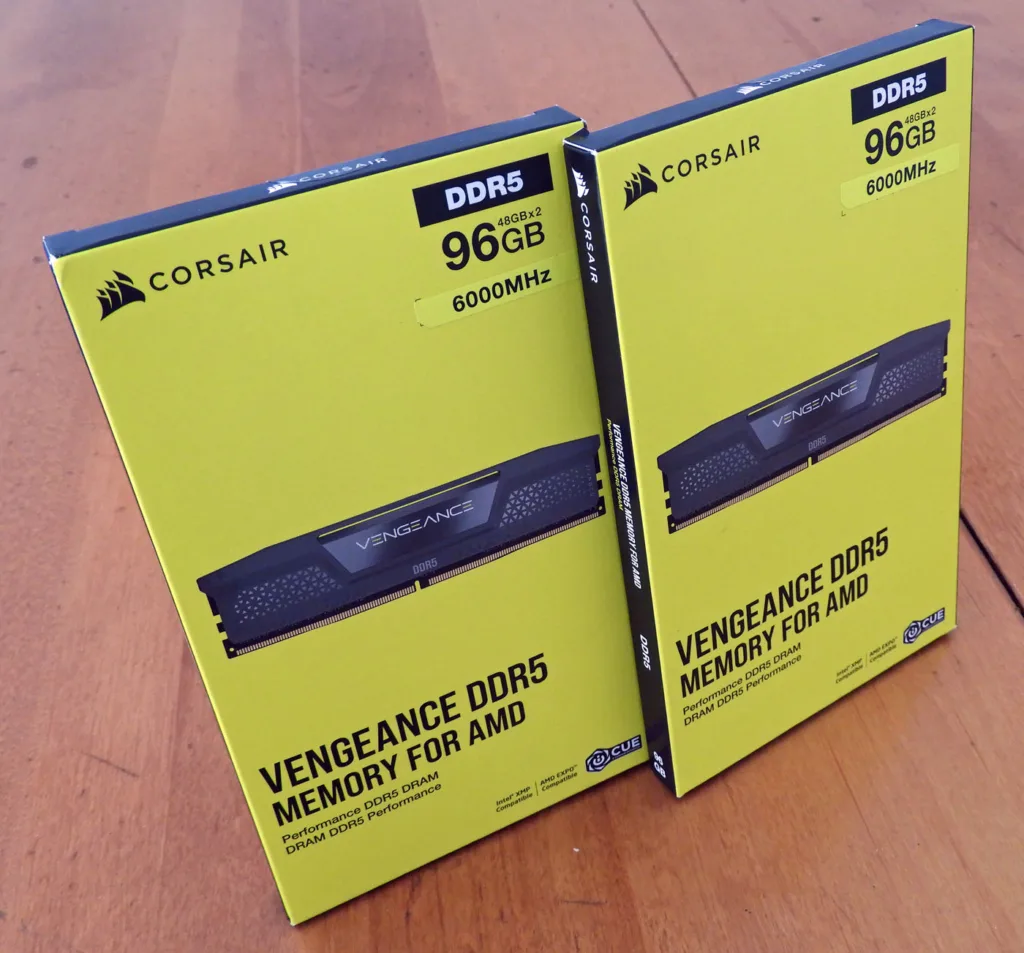
We decided to compare both the 2x48GB VENGEANCE Corsair kit and both kits in a 4x48GB configuration against the G.SKILL 2x32GB DDR5 6000 CL30 kit we currently use, and versus a T-FORCE 2x16GB DDR5 6400 CL40 memory kit. We used a full set of memory benchmarking suites and tools and five CPU-intensive games to see if we could determine how DDR5 speeds, latency, and RAM capacity make a practical performance difference for gamers, creators, workstation, and AI local language machine (LLM) users.
We specifically asked for a review sample of the Corsair VENGEANCE DDR5 96GB (2x48GB) 6000MHz CL30 (CMK96GX5M2B6000Z30) kit, as AMD considers 6000MHz (or really 6000MT/s) and CL30 or below the performance sweet spot for the AM5 x870e motherboard and the 9000 series X3D Ryzen 9 CPUs.
The technical specifications are from Corsair’s website, and the memory is optimized for AMD EXPO as well as Intel XMP. They are very impressive specifications for a 48GB module and match the specs of our 32GB G.SKILL kit.
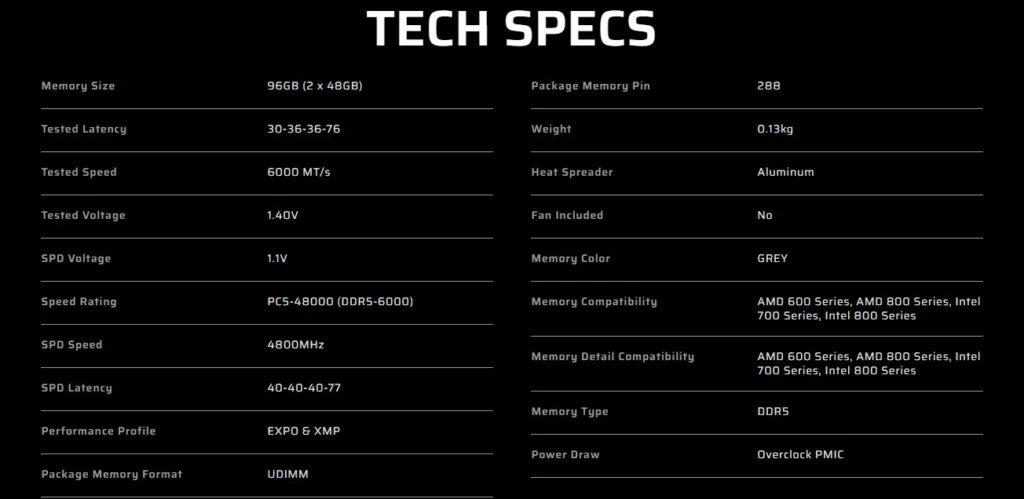
Test Configuration
Hardware
- Ryzen 9 9950X3D supplied by AMD
- ASRock Taichi X870e BIOS 3.40 – All RAM at EXPO/XMP except 4x48GB/ PBO to -0.3mV and TDP to 85C / SVM disabled, supplied by AMD/ASRock
- 4x48GB Corsair VENGEANCE DDR5 6000 at 4400MT/s CL30-36-36-76 UCLK=MEMCLK (Custom), supplied by Corsair
- 2x48GB Corsair VENGEANCE DDR5 6000 CL30-36-36-96 UCLK=MEMCLK (EXPO), supplied by Corsair
- 2x32GB G.SKILL Trident Z5 Neo DDR5 6000 CL30-36-36-96 UCLK=MEMCLK (EXPO)
- 2x16GB T-FORCE Delta RGB DDR5 6400MHz CL40-40-40-84 UCLK=MEMCLK/2 (XMP), supplied by TEAMGROUP
- Samsung 990 Pro 1TB Gen4x4 M.2 2280 PCIe 4.0 (7450/6900MBps) C: drive, supplied by AMD/Samsung
- TEAMGROUP MP44 4TB SLC Cache Gen4x4 M.2 2280 PCIe 4.0 (7000/6000MBps) Storage
- RTX 5090 Founders Edition, supplied by NVIDIA
- Super Flower Leadex SE 1200W 80+ Platinum Power Supply Unit
- DeepCool Castle 360EX AIO
- Corsair 5000D
- LG C1 48″ 4K/120Hz
Software
- Windows 11 Professional 64-bit 2024 2H2
- Nvidia Studio driver 581.29 for apps (577.00 for PCMark 10 only) /581.29 GRD for games/3DMark. All drivers, games & apps updated
- UL 3DMark Professional, courtesy of UL
- UL Procyon Suite, courtesy of UL
- UL PCMark 10 Professional, courtesy of UL
- SPEC Workstation 4.0
- SPECviewperf 1.5
- AIDA64 Engineer, courtesy of FinalWire
- 7zip
- Blender Benchmark
- CPUZ Benchmark
- GeekBench CPU
- GeekBench AI
- HWiNFO64
- LLM Studio OpenAI’s gpt-oss 20B and 120B
- MaxxMem2
- Memory Mark (PassMark)
- Novabench Memory
- Vovsoft RAM Benchmark
- V-Ray CPU Benchmark
- y-cruncher
Note: For each RAM kit, voltages, timings, UCLK:MEMCLK ratios, and Command Rates (1T) are set by their respective default XMP or EXPO profiles in the BIOS. We did not attempt any overclocking or timing adjustments except with the 4x48GB Corsair Vengeance memory configuration.
Unboxing
Corsair offers a lifetime warranty for its VENGEANCE DDR5 desktop memory. It arrives in a yellow box as a 2x48GB matched kit with its specifications viewable for retail marketing.
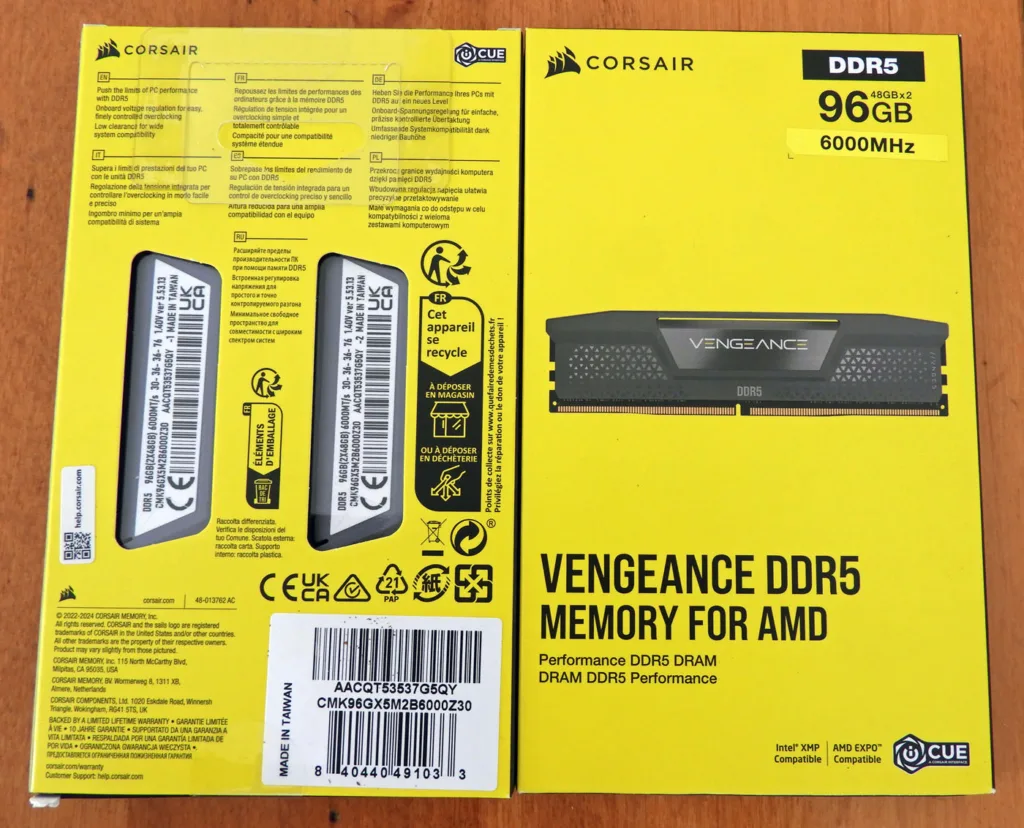
As usual, it is packed in an anti-static plastic clamshell with safety and compliance information.
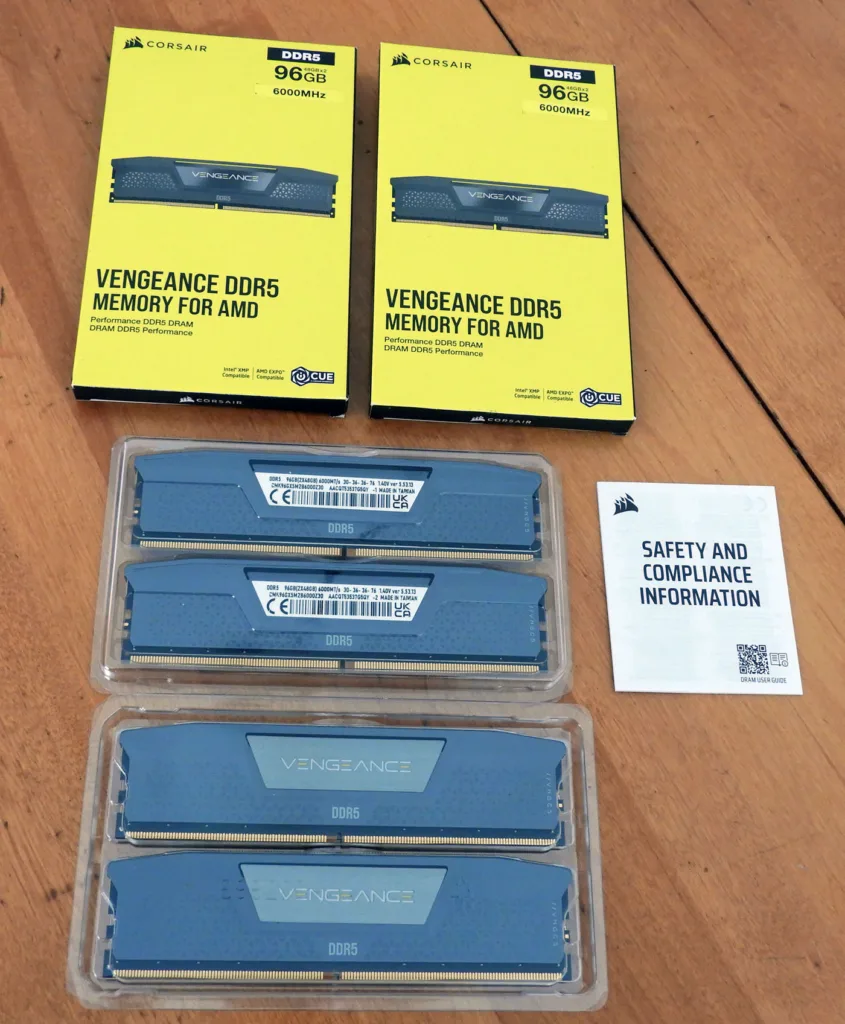
The VENGEANCE memory is neither flashy nor RGB, but it is in a compact form factor for easy installation with any CPU cooler. It boasts a solid aluminum heat spreader covering a high-performance PCB, and each kit is hand-sorted and tightly screened to function perfectly as a perfectly matched 2×48 kit.
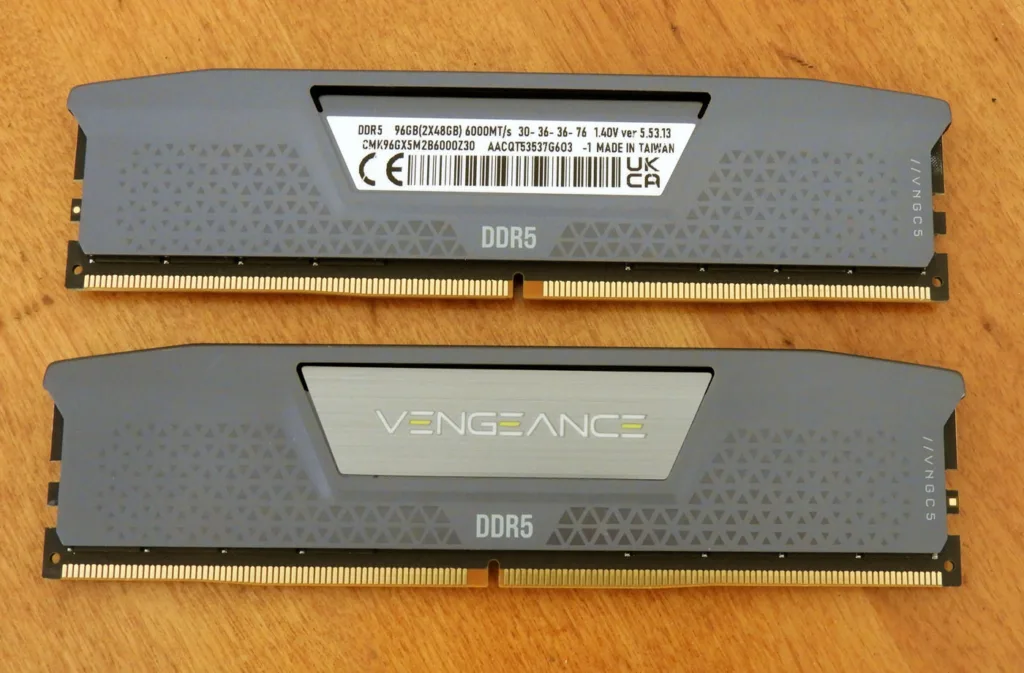
HWiNFO64
Here are Corsair’s VENGEANCE timings and voltage from the system summary.
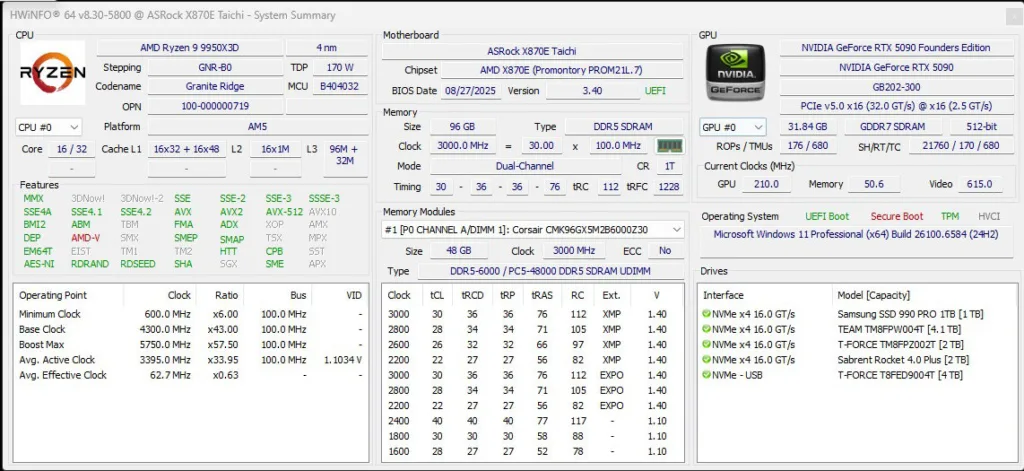
The clock speed is correctly shown as 3000MHz, and since it is DDR or Double Data Rate, which allows data to be transferred twice per clock cycle, it performs at 6000MT/s – megatransfers per second. We will continue to use MT/s since it represents the actual effective data transfer rate of the memory more accurately than the widely used megahertz (MHz) naming.
Using Two Kits vs. Using One Kit
It’s important to note that one cannot use two kits, even of the same brand and timings, in a 4×4 configuration and expect EXPO settings. Adding a second memory kit to an AM5 motherboard usually results in lower speeds due to the increased stress placed on the CPU’s integrated memory controller (IMC). AMD desktop consumer motherboards have physical and electrical limitations using four DDR5 DIMMs versus two.
Consumer AM5 motherboards are built to prioritize maximum clock speeds for a two-DIMM configuration – usually slots A2 and B2 – for the best signal integrity and shortest path. The motherboard traces are designed to have the best signal integrity and shortest path when only two of the four slots are populated, typically in slots A2 and B2.
When all four slots are used, the signal path becomes much more complex, reducing signal integrity and forcing the system to run the memory at a lower frequency – usually defaulting to 3600MT/s. We were only able to achieve 4400MT/s, even with a small voltage increase; Using 4600MT/s defaulted immediately back to 3600MT/s.
Corsair was easily able to achieve 5200MT/s with their own MSI Carbon board, and we are speculating that it’s because of our ASRock Taichi X870e motherboard, which is known all over social media for damaging X3D CPUs until BIOS 3.40 was released. It seems possible that the new BIOS may be limiting the Corsair VENGEANCE’s true potential, as ASRock may now be erring on the side of safety. However, we can only review what we have to work with.
However, the specifications look great for a 2×48 GB kit, so let’s head to our detailed benchmarking.
Gaming Performance Summary Chart & 3DMark
Although our focus is absolutely not on gaming, here are the summary charts of five games known to be CPU-intensive and two synthetic 3DMark tests. The highest settings were chosen, and the settings are listed on the charts. The benches were run at 3840×2160 to compare DDR performance.

All of the memory kits generally run the above games relatively closely in performance. Even the VENGEANCE 4x48GB kit at only 4400MT/s does reasonably well, which means – although not ideal – a 192GB workstation-type setup can work for gaming. Even the 2x16GB T-Force DDR5 6400 CL40 kit does reasonably well, although it is hobbled somewhat by running at UCLK=MEMCLK/2 as set in the ASRock BIOS by its profile.
It is very unlikely – except perhaps with some heavily modified games like Skylines or some simulation games – that more than 64GB of memory is needed for gaming. However, using 2x48GB DDR5 has no inherent disadvantage.
3DMark
3DMark uses a specialized CPU profile test that uses from one to the maximum CPU threads available to give the average simulation time per thread. Here are the 2x48GB VENGEANCE kit’s full results.
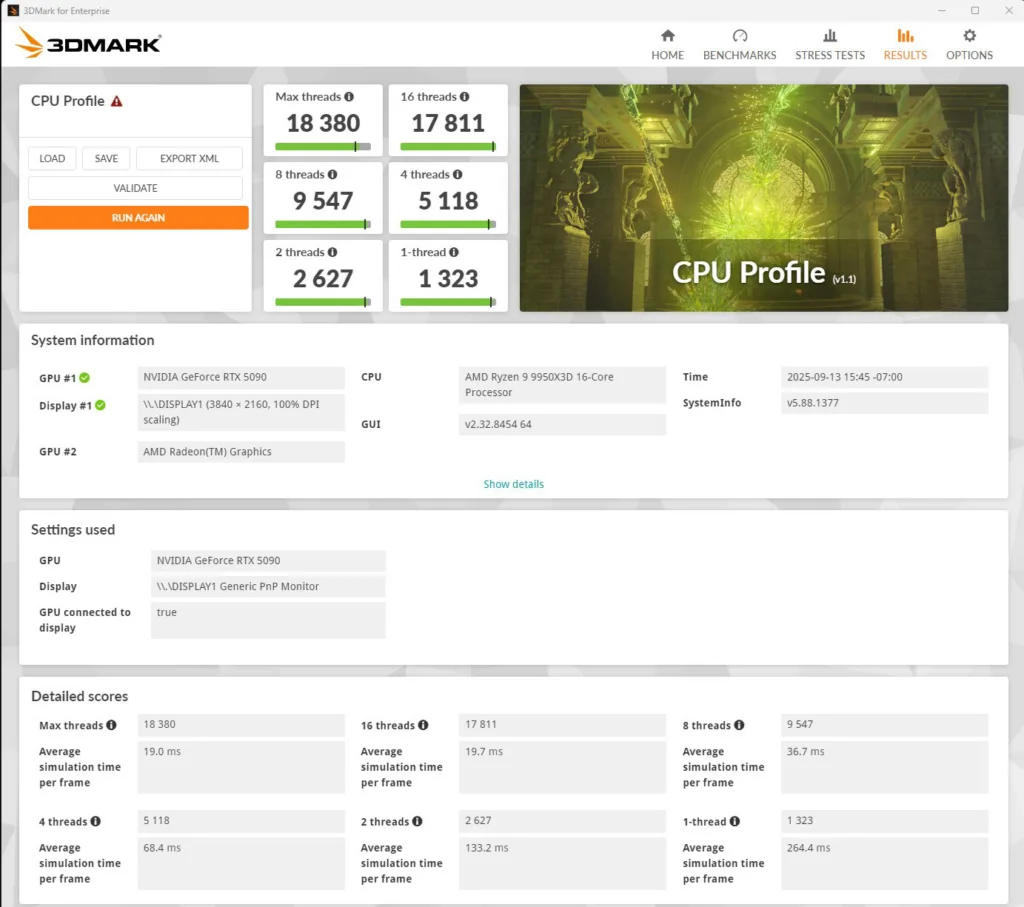
Here is the summary chart for all 4 kits using max threads, followed by Firestrike Extreme-4K Physics scores, which also depend heavily on CPU/RAM.

Let’s move on to non-gaming synthetic benchmarks specifically designed to test memory and CPU.
Synthetic Benchmarks
AIDA64 v7.99.7859 Beta Engineer
AIDA64 is an important industry tool for benchmarkers. Its memory bandwidth benchmarks (Memory Read, Memory Write, and Memory Copy) measure the maximum available memory data transfer bandwidth. AIDA64’s benchmark code methods are written in Assembly language, and they are well-optimized. We use the Engineer’s full version of AIDA64 courtesy of FinalWire. AIDA64 is free to try and use for 30 days.
The AIDA64 Memory Latency benchmark measures the typical delay from when the CPU reads data from system memory. Memory latency time means the time is accurately measured from the issuing of the read command until the data arrives in the integer registers of the CPU. It also tests Memory Read, Write, and Copy speeds besides Cache.
Here are the Corsair VENGEANCE 6000 2x48GB Cache & Memory Benchmark results.
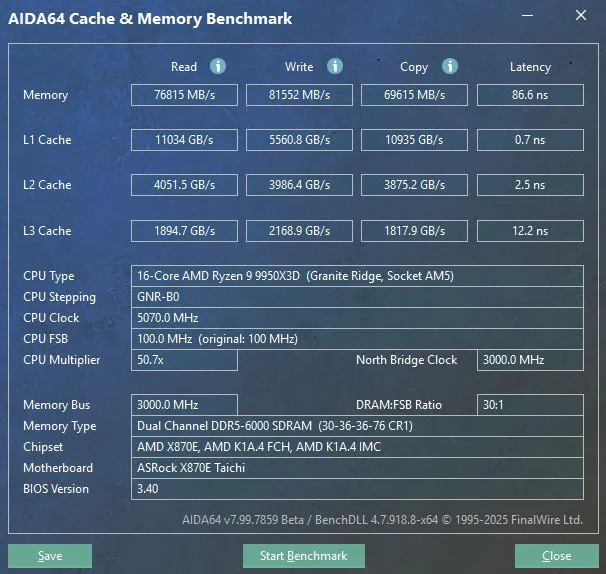
Here is the summary chart of the above, along with the CPU benchmarks that depend on fast RAM to score higher.
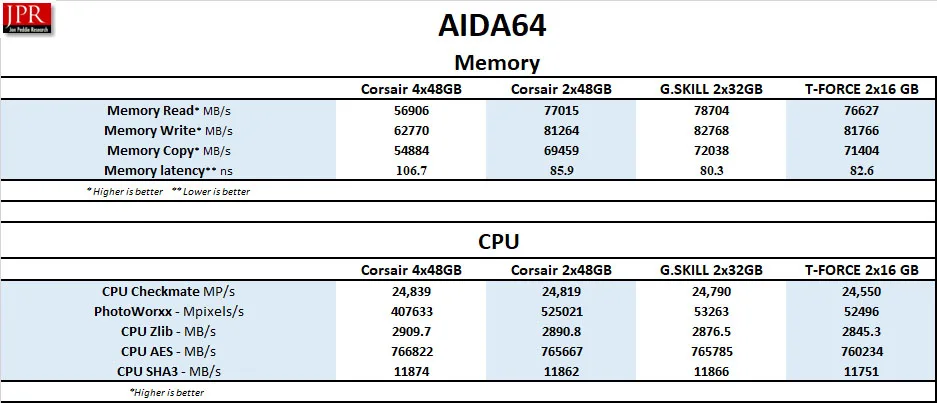
It will not be surprising for most of the synthetic benchmarks that the 2x32GB G.SKILL memory kit exhibits less latency and slightly higher performance than the 2x48GB Corsair kit. Its 3Gx8 memory configuration introduces additional inherent latency, bringing a tradeoff between sheer performance and increased memory density.
CPU-Z
CPU-Z benchmark is a quick synthetic test found in the CPU-Z utility to measure a CPU’s single- and multi-thread performance, providing a relative score to compare against other CPUs.

We include it only for a rough comparison. On to MaxxMem²
MaxxMem²
MaxxMem² v3.00.24.109 is another free small memory benchmarking program designed to compare memory performance, including latency.

The results are in line with the other memory tests.
PassMark Software’s PerformanceTest tool – Memory Mark
PassMark Software’s PerformanceTest tool includes Memory Mark, which tests the memory database operations, uncached and cached reads, writes, and latency.

Again, no surprises. Next up, Novabench.
Novabench
Novabench is a very quick synthetic benching utility that also gives a memory score, which shows the peak transfer speed as well as latency. Here is the summary.

This time the T-FORCE DDR5 scores lowest despite having the second fastest transfer peak speed and second lowest latency.
Vovsoft RAM Benchmark
Vovsoft RAM Benchmark is another free semi-synthetic benchmark that mimics the way real applications use large amounts of RAM by allowing users to customize the block size. We tested multiple block sizes. An ‘x’ means the block is too large to be run by the memory kit.

The Corsair VENGEANCE 4x48GB kit was the only configuration able to run a 100GB block. It was competitive in all of the other block sizes.
7-Zip benchmark
The 7-Zip built-in benchmark we use is a synthetic benchmark that tests LZMA and LZMA2 algorithms compression/decompression and gives a rating in GIPS (giga or billion instructions per second), which is calculated from the measured speed. It is somewhat dependent on RAM speeds.

As in the previous test, we increased the directory size until only the 4x48GB Corsair VENGEANCE configuration could process 768MB. It was also the second fastest at compressing/decompressing a 128MB directory.
Y-cruncher
Y-cruncher is a synthetic benchmark that tests the raw computational power of a system by calculating Pi, pushing the CPU and RAM to their limits. It is a free test that is fully multi-threaded. We chose the 20 billion digit test and kept the test running only in RAM, with no swapping to disk allowed.

The 2x16GB kit was unable to process 10 billion digits, although the other three kits were.
Let’s leave synthetic benchmarks behind and move on to more real-world scenario benchmarking.
Real World Benchmarks
Geekbench 6 CPU and Geekbench AI Benchmarks
GeekBench 6 is a well-established CPU benchmarking program that runs a series of tests and times how long the processor takes to complete the tasks. Faster memory means the CPU may be able to complete tasks faster.
Both Geekbench and Geekbench AI are hybrid benchmarks straddling a line between synthetic and real-world testing. It simulates real-world scenarios and tasks, including machine learning, yet focuses on practical workloads.
Here are the summary results of our four memory configurations:
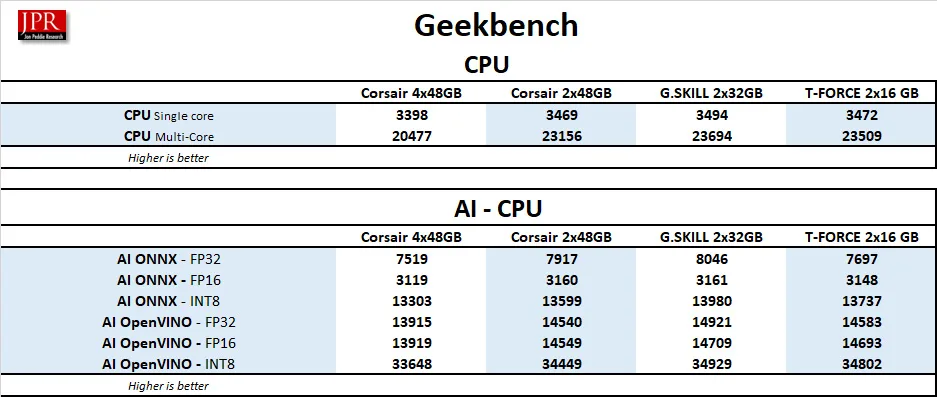
Let’s take a look at Blender.
Blender 4.5.0 Benchmark
Blender is generally considered a real-world benchmark because it renders three files of 3D models and scenes that are based on professional production tasks.
We generally see performance increase with faster CPU and memory speeds, so we used the very latest version of the Blender 4.5.0 benchmark, which primarily measures CPU performance in rendering production files. Higher is better as the benchmark automatically renders a scene multiple times and gives the results as samples per minute. It may be downloaded from here.
The Corsair VENGEANCE Blender 2x48GB results are shown below.
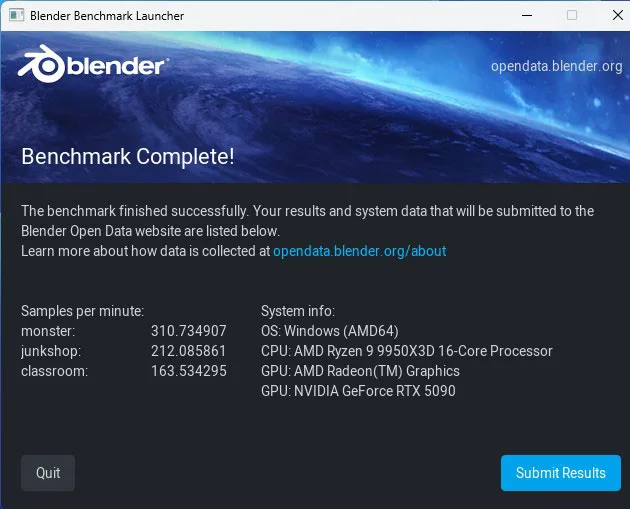
Here is the Summary.

Except for the 4x48GB configuration, all of the kits perform similarly.
Next, we benchmark using Cinebench.
Cinebench 2024
Cinebench 2024 is based on MAXON’s professional 3D content creation suite, Cinema 4D. The latest version of Cinebench uses real-world rendering tasks from the Redshift engine. It provides scores for multi-core and single-core CPU (as well as GPU) accurately and automatically, and is an excellent tool to compare CPU/memory performance.
Now the summary chart.

The 4x48GB configuration is no doubt held back by its slower transfer rate.
Let’s look at the V-Ray CPU benchmark next.
V-Ray CPU Benchmark
The V-Ray benchmark is a real-world benchmark as it uses the popular V-Ray rendering engine to test a system’s performance. The benchmark uses the same technology that visual effects and design professionals use for their projects. We chose the CPU benchmark instead of using the GPU.

Let’s check out real-world testing benchmark suites.
PCMark 10 Professional Edition
PCMark 10 has multiple tests which use real-world timed benchmarks, including web browsing, video group chat, photo, batch, and video editing, music and video tests, and even mainstream gaming. PCMark 10 offers three primary tests, and we chose the Extended suite. We use the Professional Edition courtesy of UL.
In our summary, we are focusing primarily on the overall score as well as photo and video editing. UL’s Procyon Office benchmark suite has largely superseded PCMark 10 (which is still current and supported), but we don’t have the full versions of Adobe’s Lightroom or Photoshop.

This time, the VENGEANCE 4x48GB configuration does relatively well, getting the second-highest overall score.
Procyon Suite
UL’s Procyon benchmark suite is another hybrid approach using a combination of real-world applications and simulated workloads to measure performance. Procyon Office tests real-world tasks within Microsoft Office, while the AI Inference Benchmarks use common machine-learning tasks to measure performance.
Procyon Office
The Office results are very detailed as shown by the Corsair VENGEANCE 2x48GB results:
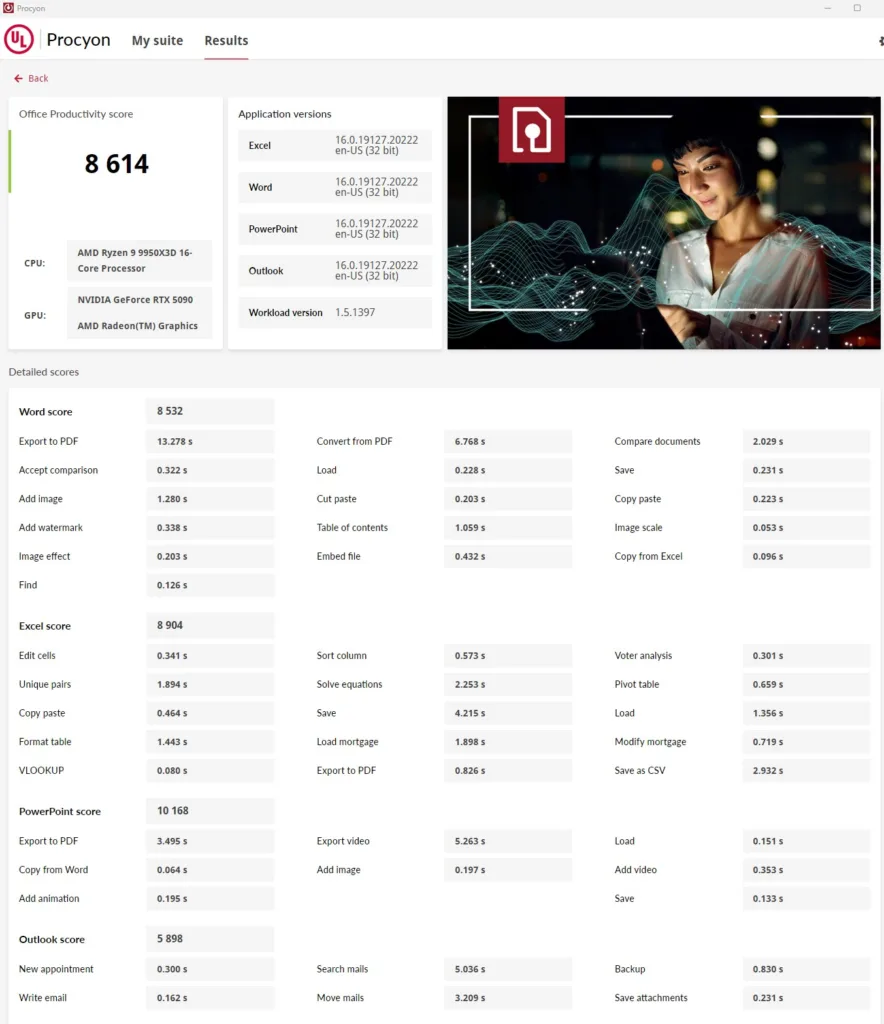
Here is the summary:

The VENGEANCE 4x48GB configuration got the highest Word score while the 2x48GB kit got the highest PowerPoint score.
Procyon AI Computer Vision Benchmark
The Procyon AI Computer Vision Benchmark measures how AI inference engines perform. We used the Windows Machine Learning, Float 32 benchmark

UL Procyon AI Image Generation benchmark
The UL Procyon AI Image Generation benchmark measures inference performance for Stable Diffusion models, and we used their most demanding Stable Diffusion XL (FP16) workload. It primarily runs on the GPU but we included it for completeness

Because it runs on the GPU, there isn’t a lot of difference between the results.
Procyon AI Text Generation Benchmark
The Procyon AI Text Generation Benchmark tests AI performance with multiple LLM AI models. Again, it runs primarily on the GPU and depends on vRAM. However, when using the IGP, system RAM comes into play. Only the 2x48GB and 4x48GB configurations were able to complete some of those tests.
Here is the summary:

Again, using the GPU, there isn’t a lot of difference. Let’s move on to SPEC workstation benchmarks.
SPECworkstation 4.0 Benchmarks
All of the SPECworkstation 4.0 benchmarks are based on professional applications, most of which are in the CAD/CAM or media and entertainment fields. All of these benchmarks are free except for vendors of computer-related products and/or services.
The most comprehensive workstation benchmark is the newly revamped 4.0 version. It’s a free-standing benchmark that does not require ancillary software. It measures GPU, CPU, storage, and all other major aspects of workstation performance based on actual applications and representative workloads. It now features a new category of tests focusing on AI and ML workloads and has updated many others over the older version.
Here is our SPECworkstation 4.0 summary.
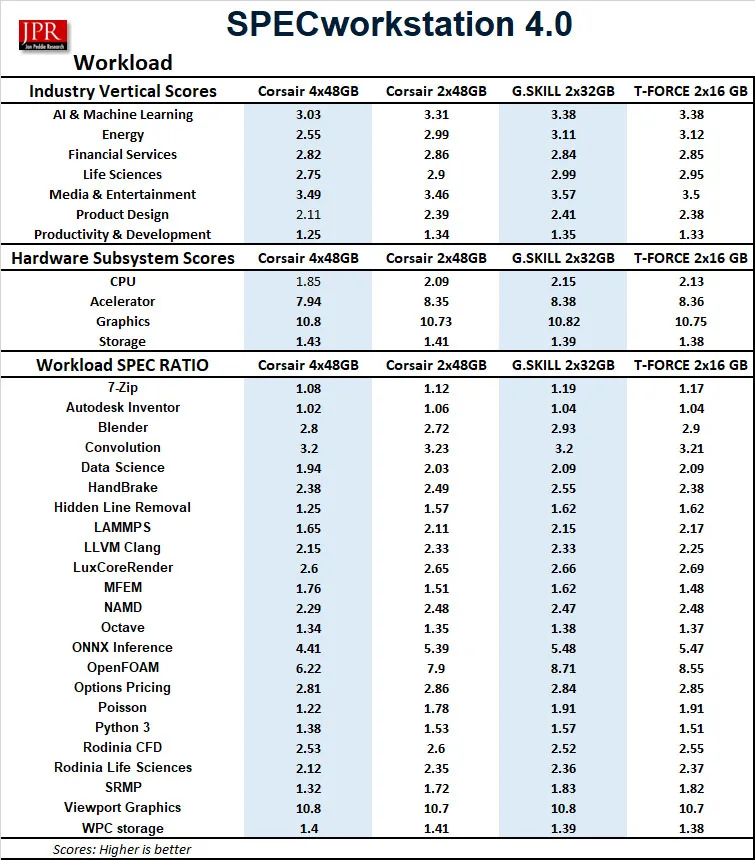
We were somewhat disappointed that the VENGEANCE 4x48GB configuration did not score particularly high – no doubt due to running at only 4400MT/s compared with the other kits, which ran at 6000MT/s. However, the 2x48GB Corsair VENGEANCE kit did quite well.
SPECviewperf 15
Specviewperf 15 was also completely revamped over the 2020 version. It uses system RAM in conjunction with the GPU for its performance benchmarks. It simulates professional application workloads, requiring large system resources to load and manipulate large datasets before being rendered by the GPU.
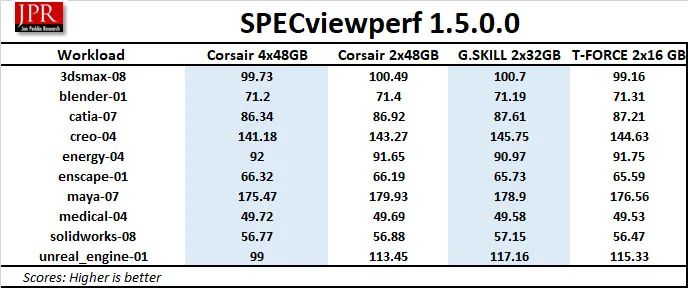
Except for the Unreal Engine benchmark, the Corsair VENGEANCE 4x48GB configuration did well, and the 2x48GB kit performed excellently.
Finally, we look at LM Studio.
LM Studio
LM Studio is a very powerful open source desktop application that brings the capabilities of Large Language Models (LLMs) directly to local PCs without requiring a connection to the cloud. It’s a platform for downloading, running, and experimenting with a very large variety of open-source LLMs. It’s perfect for users who want privacy and full control of their data. It’s unlike using ChatGPT or paying a subscription price while being datamined and having every one of your prompts recorded and stored.
We spent a full day with it using the 11GB OpenAI/gpt‑oss‑20b model, which ran completely on the vRAM of the RTX 5090. It was able to answer simple prompts almost instantly and showed no difference between either the 2×48 or the 4×48 RAM configurations.
However, when we downloaded the 63GB OpenAI/gpt‑oss‑120b model, we ran into this: “Partial GPU Offload Possible”.
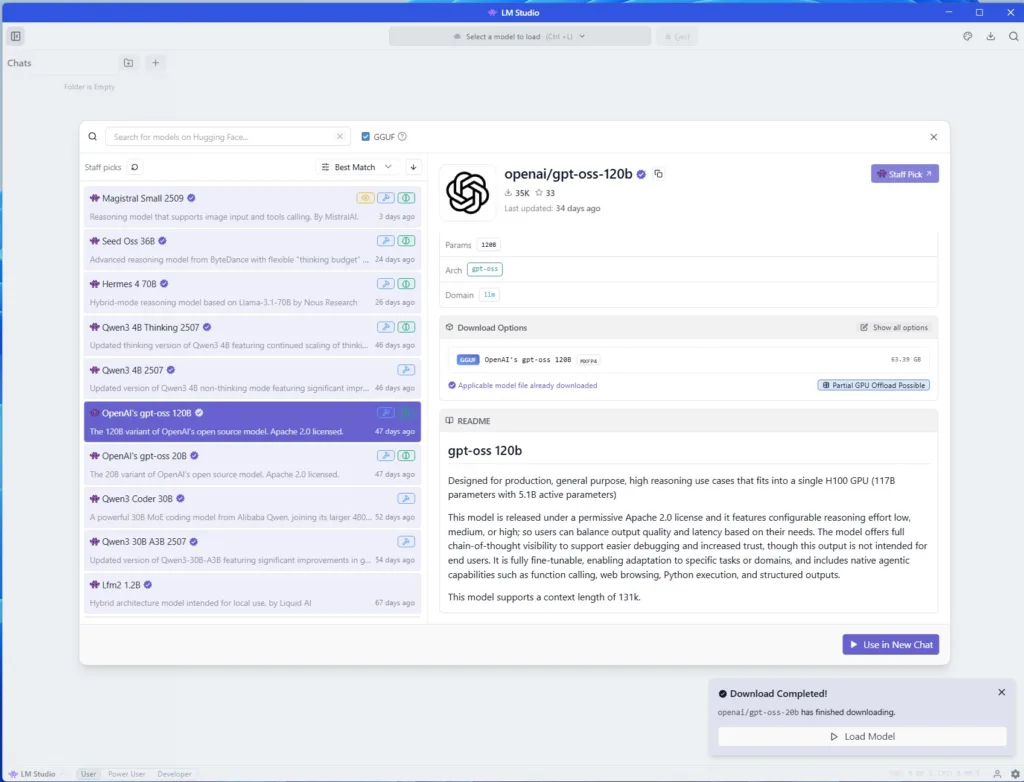
The model is so large that it cannot fit into the 32GB vRAM of the RTX 5090, and the differences between system RAM capacity quickly became apparent. Using the 120b model, the GPU offloads data to RAM, which means that with having 192GB over 96GB, the thought time is shorter and the answers are much more complex and detailed.
With more RAM on the same PC, LM Studio offloads a larger portion of a model from the slower system RAM to the much faster GPU VRAM, so the model performs better and produces far more detailed answers. Without enough RAM, the larger model makes performance compromises as system RAM is used as a “swap file”. When the model is too big for the GPU’s vRAM, LM Studio offloads part of the model to the system RAM, and constant data transfers between them create a performance bottleneck.
Here is the summary of just two prompts between the 2x48GB and the 4x48GB configurations.

Basically, using 192GB of system RAM meant the model responded twice as fast and with far more detailed and accurate answers than having only 96GB of RAM. It became clear that the lower capacity RAM appeared to cause the model to lose context, and some of the answers were clearly inaccurate compared with the higher capacity RAM-equipped PC.
Since we will be working with and benching LLMs, we are now very happy to have a 192GB RAM-equipped PC, even if it runs only at 4400MT/s compared with the 2x48GB kit at 6000MT/s.
Let’s head for the conclusion.
Conclusion and Verdict
Running DDR memory at faster clock speeds with lower latency generally results in performance gains and saves time with multiple applications. In addition, some CPU-dependent games may benefit from faster system memory, and although generally 2x16GB is sufficient for budget gamers, 32GB appears to be ideal for gaming.
Who should buy what?
- Budget Gamers: T-FORCE 2x16GB DDR5 6400 CL40
- Mainstream Gamers / Creators: G.SKILL 2x32GB DDR5 6000 CL30
- Workstation / LLM Users: Corsair VENGEANCE 2x48GB
- Heavy LLM / Large Model AI: Corsair VENGEANCE 4x48GB (192GB)
It is not surprising that for many of the synthetic benchmarks, the 2x32GB G.SKILL memory kit exhibits less latency and slightly higher performance than the 2x48GB Corsair VENGEANCE kit. Its 3Gx8 memory configuration introduces additional inherent latency, bringing a tradeoff between sheer performance and increased memory density. However, the practical differences are so small that we will use it for daily use, including for gaming, and may even be able to tighten up the timings a little, although we doubt overclocking is possible on our ASRock motherboard until perhaps a new BIOS is released.
As to using memory in a 4-slot configuration – even with the same memory kits from the same manufacturer – your results may vary. Because of the way the AMD consumer memory controller is designed, all you are guaranteed is 3600MT/s from using two identical 6000MT/s kits on a decent motherboard. We could only manage 4400MT/s while Corsair had no issues reaching 5200MT/s on their MSI Carbon motherboard.
Even so, if you want to use LLMs with large models like the OpenAI 120b model and you don’t have a professional Quadro GPU with a lot of vRAM or perhaps two RTX 5080s or 5090s, a slower 4x48GB RAM configuration produces far more accurate and detailed responses much more quickly than a very fast 2x48GB kit.
We recommend the Corsair VENGEANCE DDR5 6000 CL30 2x48GB kit, with the only caveat being its price. It is expensive at $429.99. If you are primarily a gamer, the G.SKILL 2x32GB kit at $266.99 makes more sense. However, if you need the higher capacity, the Corsair VENGEANCE 2x48GB DDR 6000 CL30 kit is outstanding and is perfect for an AMD X3D CPU to receive our highest recommendation.